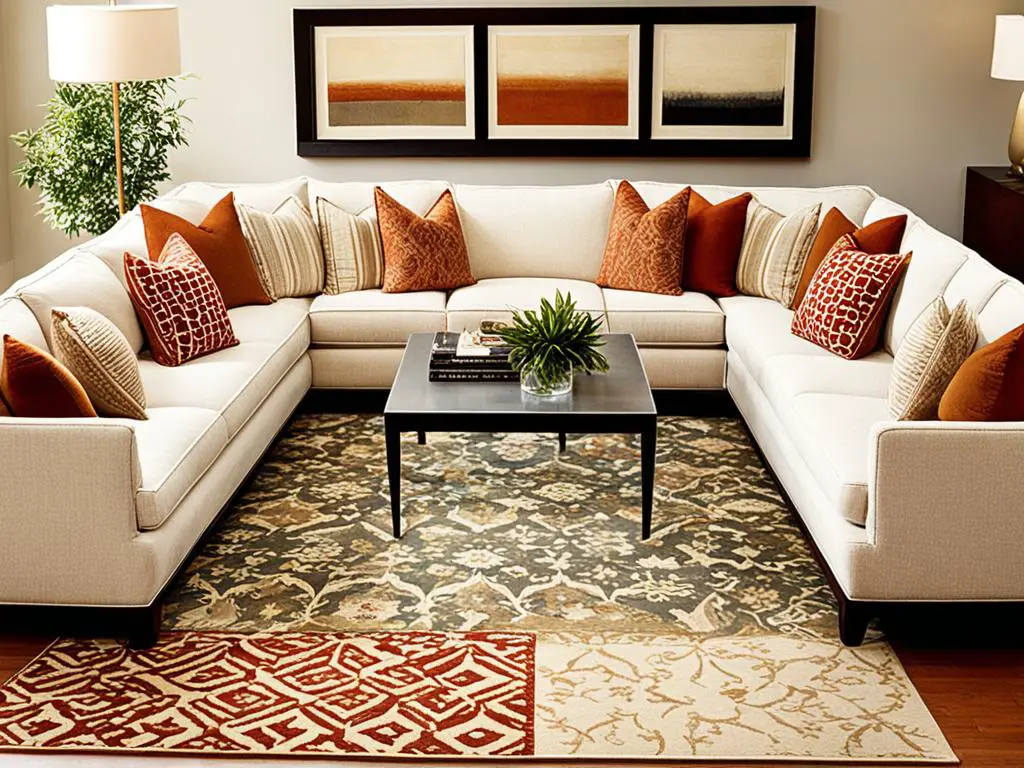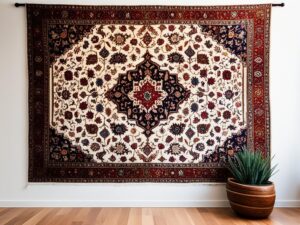Welcome to our comprehensive guide on coordinating rugs in adjacent rooms. Whether you’re designing an open floor plan or have connected living spaces, proper rug coordination can make a significant impact on the overall aesthetic and functionality of your home. In this article, we will explore various rug styles, textures, and color schemes to help you achieve a seamless and harmonious look.
Key Takeaways
- Coordinating rugs in adjacent rooms helps create a cohesive flow and visually connects the spaces.
- Identify the primary color scheme in each room and choose rugs with complementary colors or patterns.
- Vary the scale of patterns in each rug to add visual interest.
- Consider incorporating rugs with similar textures, such as natural fiber or wool rugs, for added depth.
- Layering rugs can create a unique and personalized look.
The Importance of Coordinating Rugs
Rugs are more than just floor coverings; they are essential elements in interior design that can transform a space. When it comes to open-concept floor plans or adjacent rooms, coordinating rugs becomes even more critical. By thoughtfully selecting rugs that complement each other in terms of color, texture, and style, you can create a harmonious flow and connection between the rooms.
In open-concept spaces, where multiple areas seamlessly blend into one another, rugs act as anchors for furniture and create a visual separation between different zones. They help define individual spaces, adding structure and clarity within the larger area. Whether it’s a transition from the living room to the dining area or from the kitchen to the family room, coordinating rugs ensure a smooth and cohesive look.
When choosing rugs for adjacent rooms, it’s essential to consider how they interact with one another. The right rug coordination can enhance the overall aesthetic and create a unified design scheme. By harmonizing color palettes, coordinating patterns, and balancing textures, you can achieve a seamless transition from room to room.
Coordinating rugs in neighboring spaces not only creates a visually pleasing environment but also contributes to the functionality of the rooms. It helps establish distinct areas for different activities, facilitating better organization and flow within your home.
Whether you’re looking for room-to-room rug styling ideas, adjacent room rug design inspiration, or tips on coordinating carpets in neighboring spaces, you’ve come to the right place. In the following sections, we’ll delve deeper into the art of rug coordination, providing you with expert advice, practical tips, and creative ideas to achieve a stunning and cohesive look throughout your home.
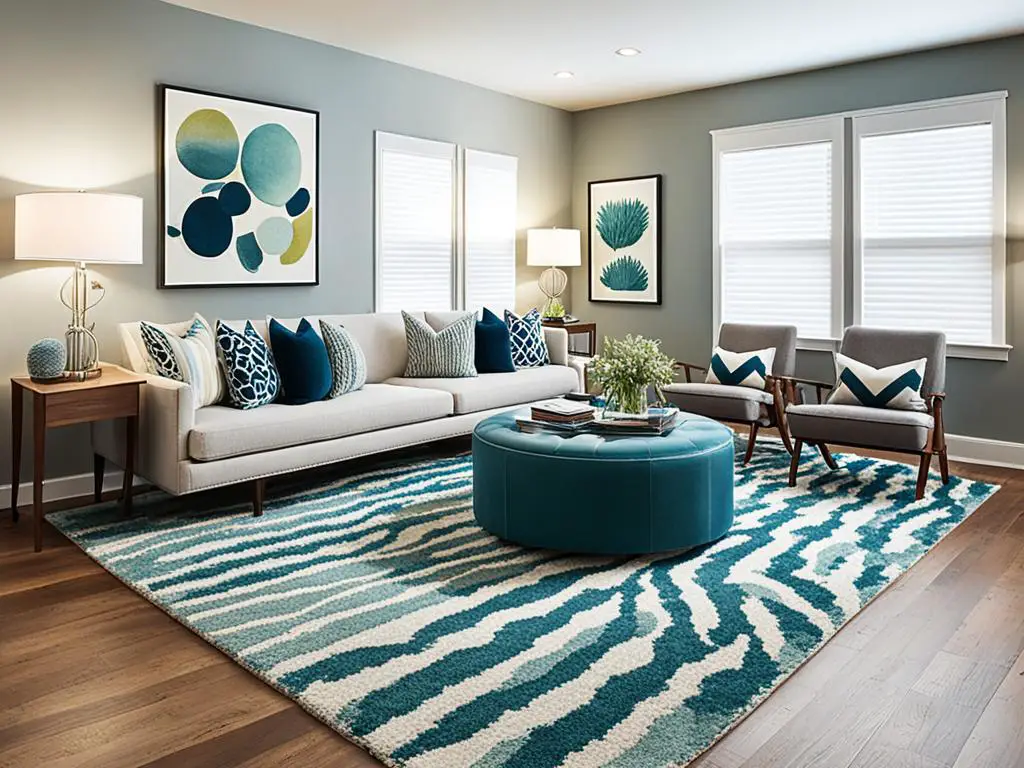
Let’s explore the power of coordinating rugs and discover how they can transform your open-concept floor plan or adjacent rooms into inviting and cohesive spaces.
Tips for Coordinating Rugs in Adjacent Rooms
When it comes to coordinating rugs in adjacent rooms, a few essential tips can help you achieve a seamless and harmonious look. By considering factors like color, pattern, texture, and layering, you can create a visually appealing and connected space. Let’s dive into these tips:
1. Complementary Colors and Patterns
Start by identifying the primary color scheme used in both rooms. Look for rugs with complementary colors or patterns that harmonize with each other. This will create a sense of cohesion and flow between the adjoining areas. Varying the scale of patterns in each rug can also add visual interest and prevent monotony.
2. Consistent Textures
Incorporate rugs with similar textures to add depth and variety to the space. Natural fiber rugs, such as jute or sisal, can bring a touch of earthiness and warmth. Alternatively, wool rugs offer a luxurious feel underfoot and can enhance the cozy ambiance of your rooms. By maintaining consistency in texture, you ensure a seamless transition between the spaces.
3. Layering for a Personal Touch
Don’t be afraid to experiment with layering rugs to create a unique and personalized look. Layering allows you to combine different colors, patterns, and textures, adding dimension and visual interest to your rooms. You can place a smaller rug with a bolder pattern or color scheme on top of a larger, neutral rug to create a stylish and contemporary arrangement.
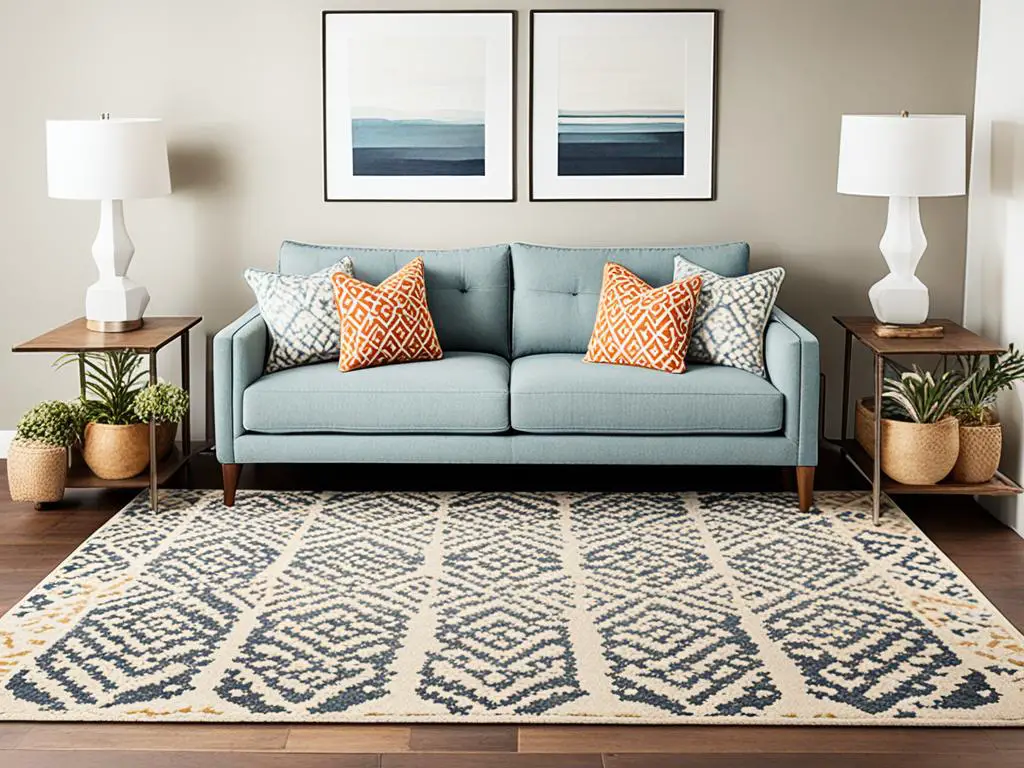
4. Harmonious Transition
Ensure a seamless transition between the rugs in adjacent rooms by considering their placement and alignment. Aim to create a sense of continuity and flow, either by aligning the rugs along the same axis or by arranging them in a way that visually connects the spaces. This will create a cohesive and unified look that enhances the overall aesthetic of your home.
“By considering factors like color, pattern, texture, and layering, you can create a visually appealing and connected space.”
In summary, coordinating rugs in adjacent rooms requires careful consideration of various elements, such as color, pattern, texture, and layering. By following these tips, you can achieve a seamless rug transition between rooms, creating a harmonious and inviting atmosphere throughout your home.
| Tip | Description |
|---|---|
| Complementary Colors and Patterns | Identify the primary color scheme and choose rugs with complementary colors or patterns. |
| Consistent Textures | Incorporate rugs with similar textures, such as natural fibers or wool, for a cohesive look. |
| Layering for a Personal Touch | Experiment with layering rugs to add dimension and create a unique design. |
| Harmonious Transition | Ensure a seamless transition between rugs by considering their placement and alignment. |
Coordinating Rugs in an Open Floor Plan
In an open floor plan, it’s important to visually separate different living spaces while maintaining a cohesive flow. Area rugs are a great tool for achieving this. Start by assessing the layout of your space and determining the function for each area. Select rugs that are the appropriate shape and size for each space, such as a round rug for a dining area or a rectangular rug for a living room.
When choosing the area rug for your living room, ensure it is large enough to accommodate the front two feet of your sofa and any chairs. This will help ground the furnishings and visually connect the seating area. By strategically placing rugs in each living space, you can create a sense of definition and purpose while maintaining a seamless flow throughout your open concept floor plan.
Area Rug Layout Suggestions:
Consider the following area rug layout suggestions when coordinating rugs in an open floor plan:
- Use a large area rug to anchor the seating area in the living room. Place the front legs of your sofa and chairs on the rug to create a visually cohesive space.
- In dining areas, choose a rug that is large enough for the dining table and chairs to comfortably fit on. Make sure there is ample space around the table for pulling out chairs.
- For smaller seating areas, such as a reading nook or conversation corner, opt for a smaller rug that complements the overall design of the space.
Remember, the goal is to create a visual separation of living spaces while maintaining a sense of harmony. Choose rugs that complement each other in terms of color, texture, and style. Layering rugs can also add depth and visual interest to your open floor plan.
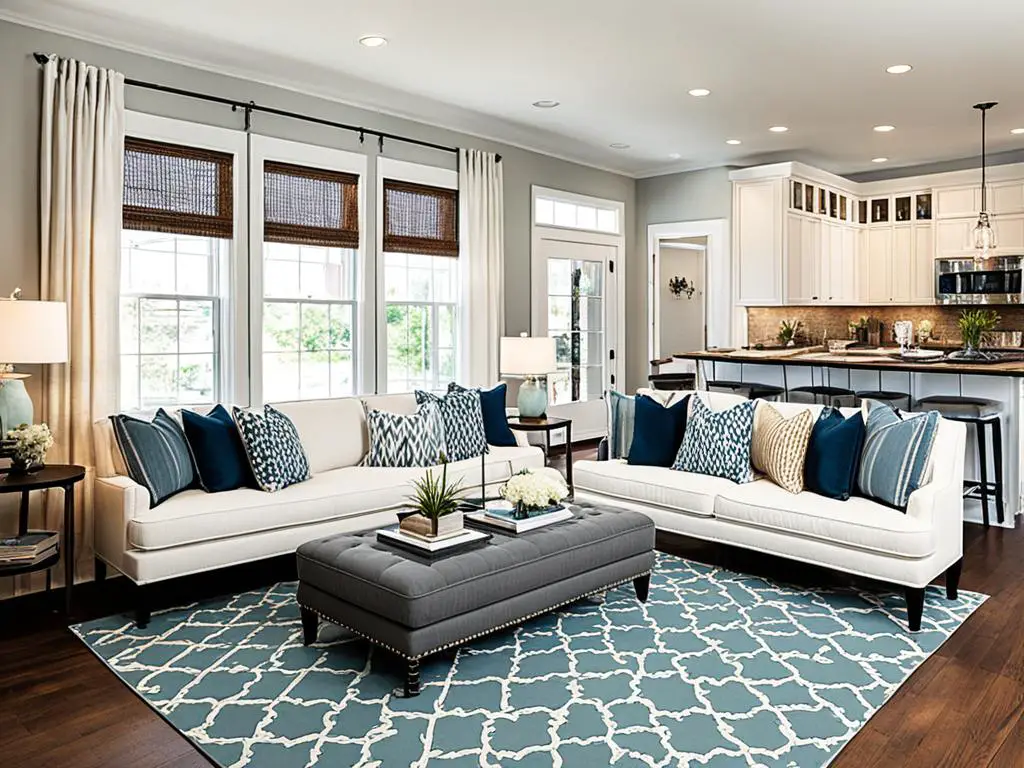
The Power of Color and Pattern in Coordinating Rugs
When it comes to coordinating rugs, color and pattern are powerful tools that can transform a space. By carefully selecting rugs that complement each other in terms of color and pattern, you can create a cohesive and visually stunning environment. Here’s how to make color and pattern work harmoniously in your rug coordination:
1. Identify the Primary Color Scheme
To start, identify the primary color scheme used in both rooms. This will serve as the foundation for your rug coordination. Look for rugs with complementary colors that harmonize with the existing color palette. For example, if one room features a rug in shades of blue, consider choosing a coordinating rug for the adjacent room that incorporates complementary blues in a different pattern or texture.
2. Mix and Match Patterns
Don’t be afraid to mix different patterns in your rug coordination. Vary the scale of each pattern and use the same or complementary colors to maintain a sense of unity. For instance, if one room has a bold geometric pattern, consider pairing it with a rug in a more subtle pattern, such as stripes or florals. This will create visual interest and add depth to the overall design.
3. Create Balance with Color Scheme
Balance is key when coordinating rugs with color. If one room has a dominant color, use it as an accent color in the adjacent room’s rug. This will establish a visual connection between the two spaces and create a sense of harmony. Experiment with different shades and tones within the same color family to add depth and variety.
“Coordinating rugs with color and pattern is like creating a beautiful symphony. The right combination can bring harmony and cohesiveness to your space.” – Interior Design Expert
4. Layer Rugs for Added Interest
If you want to add even more visual interest to your rug coordination, consider layering rugs. Start with a larger, neutral-toned rug as the base and top it with a smaller rug that features a bolder pattern or color scheme. This layered look adds texture and dimension to the space, creating a unique and personalized style.
5. Consider the Room’s Function
Lastly, consider the function of each room when coordinating rugs. Different rooms may require different approaches to color and pattern coordination. For example, a playful and vibrant pattern may work well in a child’s playroom, while a more calming and subdued pattern may be better suited for a bedroom or living room.
By harnessing the power of color and pattern in your rug coordination, you can create a cohesive look that ties your adjacent rooms together. Whether you’re aiming for a bold and eclectic design or a refined and understated look, the right combination of color and pattern will elevate your space to new heights.
Adding Texture to Coordinating Rugs
Texture plays a fundamental role in rug coordination, adding depth and visual interest to your space. One way to incorporate texture is by using natural fiber rugs, such as sisal or jute. These rugs blend well with various decorating styles and color schemes, providing a tactile element to your room.
To create a layered and textured look, consider the layered rug technique. Start with a neutral-toned jute rug as the base, and then add a smaller rug with a bolder pattern or color scheme on top. This combination adds depth and visual interest to your living area, creating a unique and personalized look.
| Benefits of Natural Fiber Rugs: | Advantages of Layered Rug Technique: |
|---|---|
|
|
Another option for adding texture is to choose a luxurious wool rug. Wool rugs offer a soft and cozy feel underfoot and can add an elegant texture to your room. These rugs come in a variety of patterns and designs, allowing you to find the perfect match for your space’s style.
Experimenting with texture in rug coordination allows you to create a visually appealing and inviting space. Whether you choose natural fiber rugs or opt for the layered rug technique, adding texture will enhance the overall aesthetic of your room.
Creating a Cohesive Look with Neutral Rugs
Neutral rugs are the secret to achieving a cohesive and harmonious look when coordinating rugs in adjacent rooms. With their versatile foundation, these rugs seamlessly blend with various design styles and color palettes, making them a timeless choice for any space.
When incorporating neutral rugs in an open floor plan, opt for colors like ivory, cream, or beige. These subtle hues create a balanced and inviting atmosphere throughout the entire area, allowing other elements of the room to shine.
By choosing a neutral color palette for larger items such as rugs, furniture, and walls, you can create a timeless design that adapts to changing decor trends and personal preferences. These neutral rugs serve as a reliable anchor for your space, complementing any style updates you may make in the future.
“Neutral rugs provide a versatile canvas that allows your furniture and decor to take the spotlight. They act as a backdrop, showcasing the unique elements and intricate details of your design.” – Emily Thompson, Interior Designer
Whether your style leans towards contemporary, minimalist, or traditional, neutral rugs offer endless possibilities. Their timeless appeal ensures that your space will always feel fresh and inviting, no matter how trends evolve.
When selecting neutral rugs, consider their texture and material to add depth and visual interest to your space. Natural fiber rugs like sisal or jute bring a touch of warmth, while layered rugs with different textures can create a cozy and inviting ambiance.
Embrace the versatility and timelessness of neutral rugs to create a cohesive, inviting, and enduring design foundation for your space.
Conclusion
Coordinating rugs in adjacent rooms or open floor plans is an essential aspect of creating a cohesive and inviting living space. By following expert tips and techniques, you can successfully pair rugs in a way that complements each other while defining individual spaces. When selecting coordinating rugs, consider factors like color, pattern, texture, and the overall design style of your space. Don’t be afraid to experiment and create a unique, personalized look. With a little creativity and attention to detail, you can achieve seamless rug coordination in any adjoining areas.
Remember that rugs play a crucial role in defining spaces and creating visual separation between different zones. A well-coordinated rug arrangement not only adds visual appeal but also ensures a harmonious flow and connection between rooms. By carefully selecting rugs that complement each other in terms of color, texture, and style, you can achieve a cohesive and inviting environment.
Incorporating neutral rugs is a timeless technique for creating a versatile foundation that can adapt to various design styles and color palettes. Neutral rugs, such as ivory, cream, or beige, can provide a harmonious and balanced atmosphere throughout an open floor plan. They also serve as a backdrop for other elements in the room, allowing you to introduce pops of color and pattern through furniture, accessories, and artwork.
When it comes to rug coordination, remember that there are no hard and fast rules. Allow your personal style and preferences to shine through while considering the overall aesthetic of your space. With the right combination of rugs, you can create a visually appealing and harmonious environment that truly feels like home.
